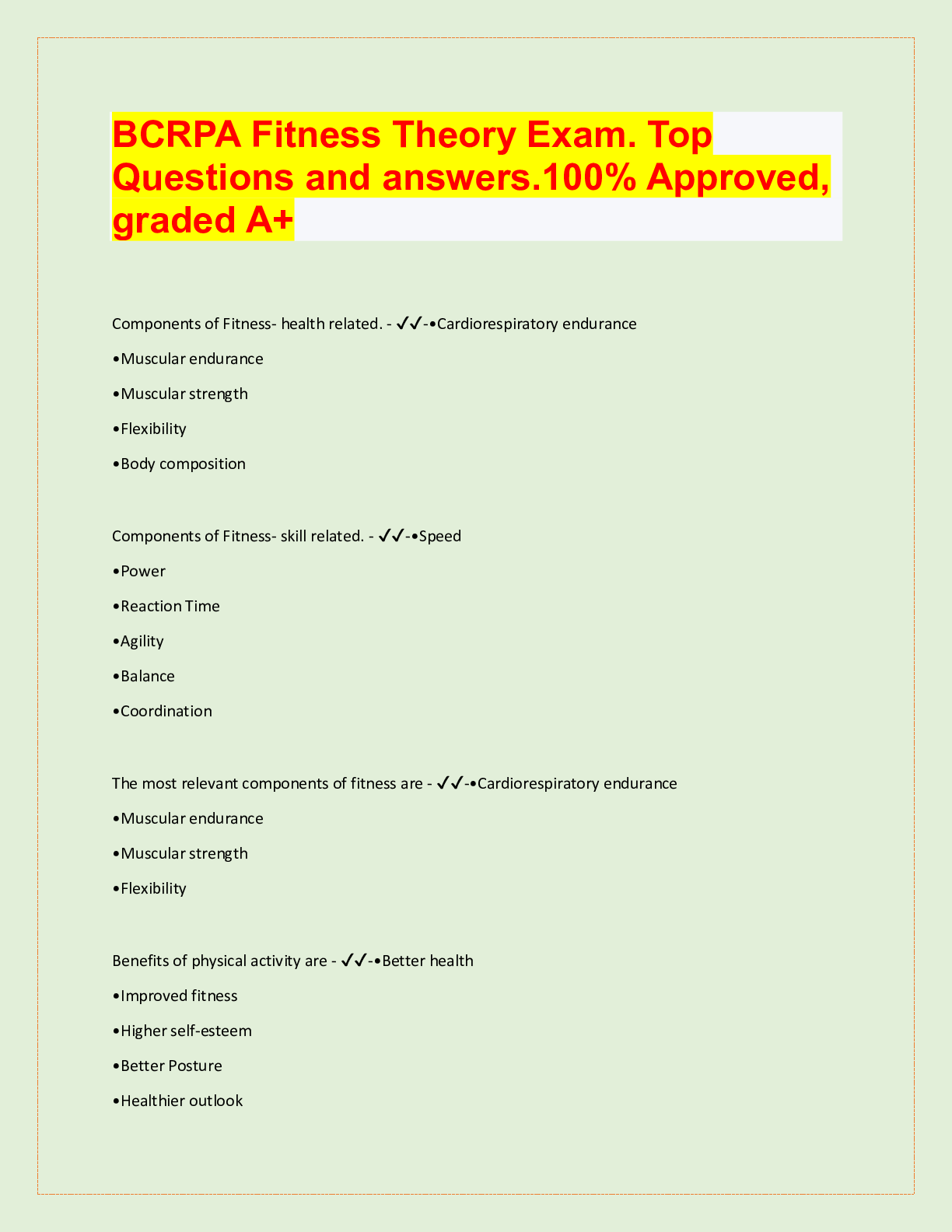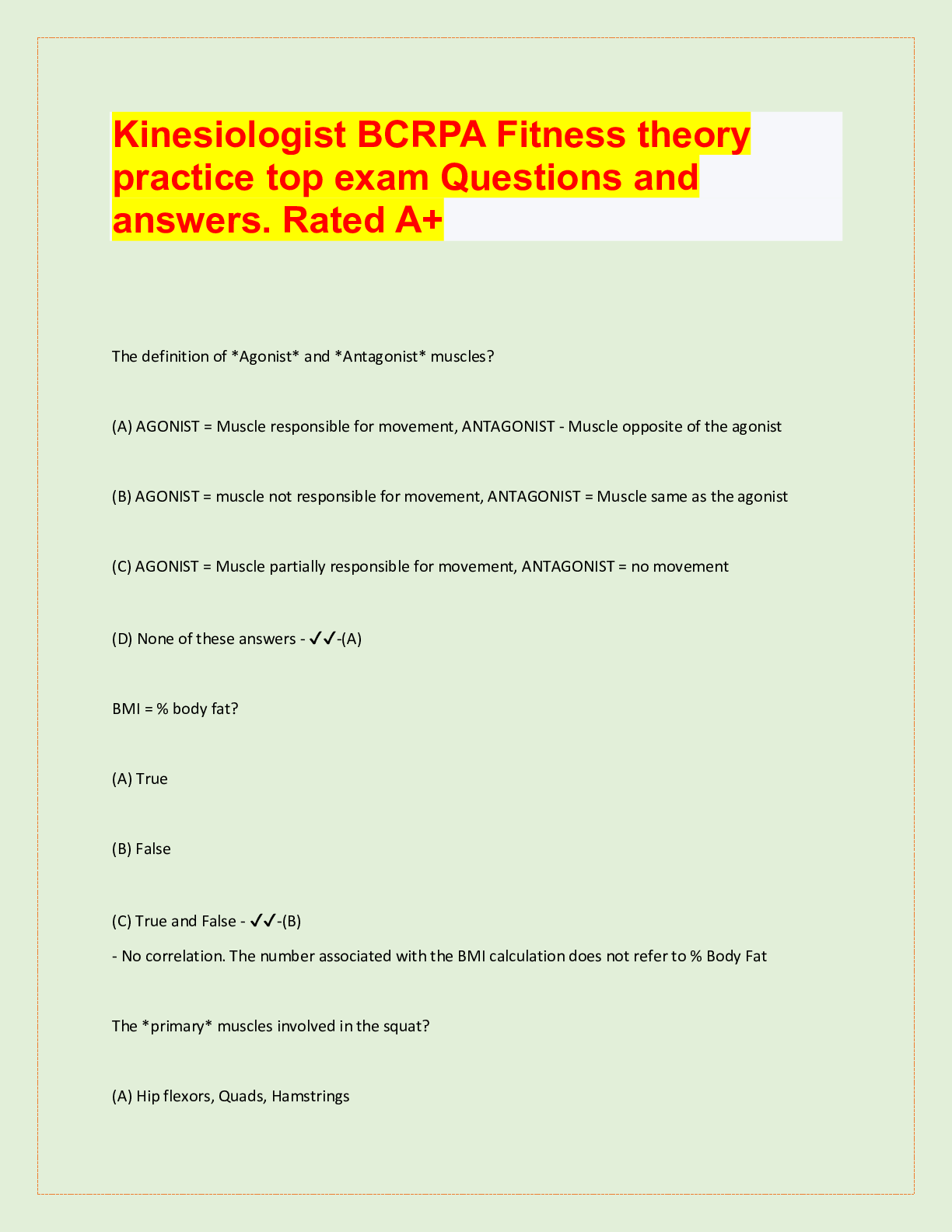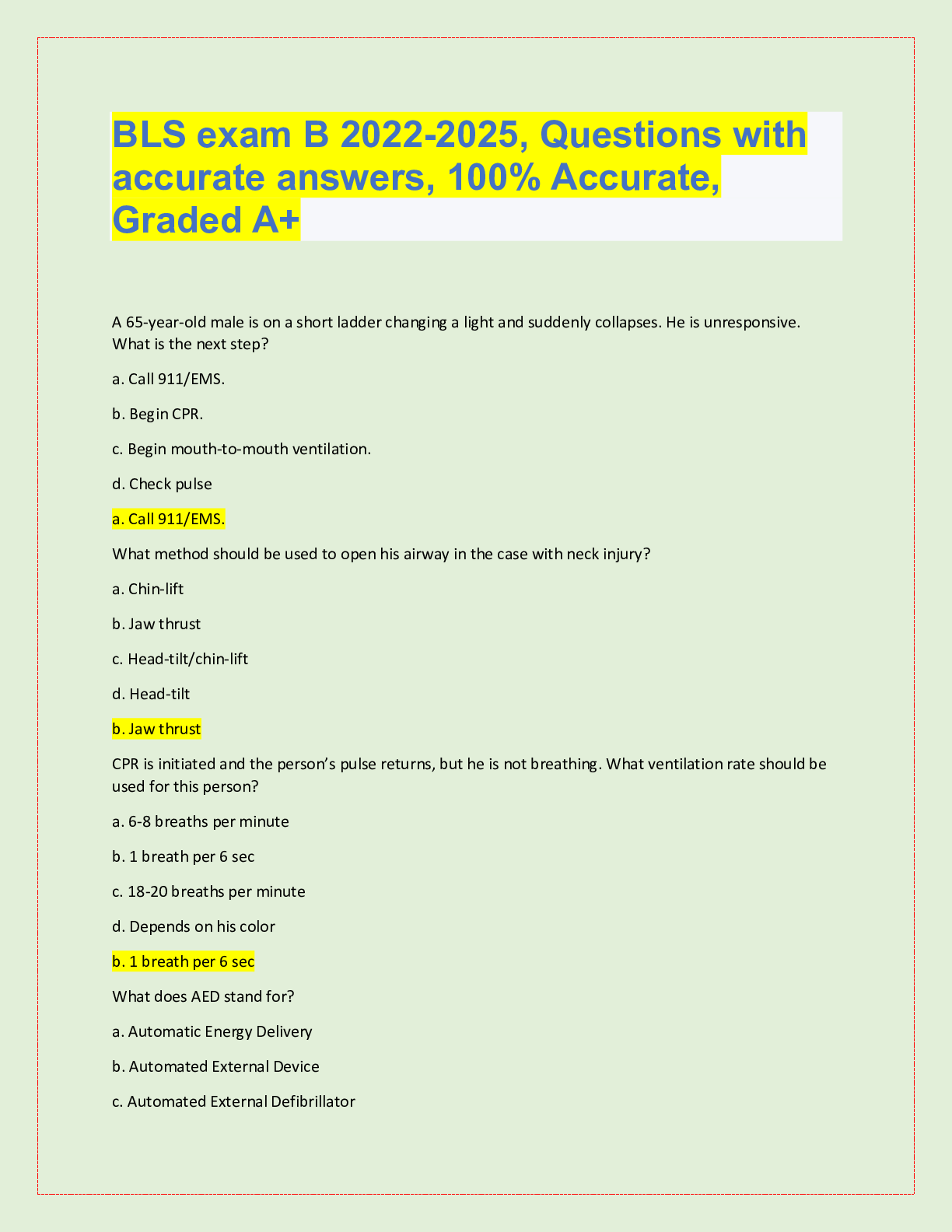Physical Education > QUESTIONS & ANSWERS > BCRPA Fitness Theory Exam. Top Questions and answers.100% Approved, graded A+ (All)
BCRPA Fitness Theory Exam. Top Questions and answers.100% Approved, graded A+
Document Content and Description Below
BCRPA Fitness Theory Exam. Top Questions and answers.100% Approved, graded A+ Components of Fitness- health related. - ✔✔-•Cardiorespiratory endurance •Muscular endurance •Muscular st... rength •Flexibility •Body composition Components of Fitness- skill related. - ✔✔-•Speed •Power •Reaction Time •Agility •Balance •Coordination The most relevant components of fitness are - ✔✔-•Cardiorespiratory endurance •Muscular endurance •Muscular strength •Flexibility Benefits of physical activity are - ✔✔-•Better health •Improved fitness •Higher self-esteem •Better Posture •Healthier outlook •Weight control •Stronger muscles and bones •Increased energy •Relaxation and reduced stress •Continued independent living in later life Health risks of inactivity - ✔✔-•Premature death •Heart disease •Obesity •High blood pressure •Adult-onset diabetes •Osteoporosis •Stroke •Depression •Colon Cancer Recreation is essential to the development of our... - ✔✔-•Children and youth Why is recreation essential to our children and youth? - ✔✔-•We learn motor skills (physical) through play and sports •We learn social skills through play and sport •We learn creativity though play and art/cultural activity •we develop intellectual capacities and concepts through play and many other life skills What is exercise? (2 definitions) - ✔✔-•Physical movement by the human body in a scheduled and consistent manner to develop the components of fitness •Exercise is structured physical activity undertaken to develop, maintain or improve physical fitness. Physical activity could be characterized as - ✔✔-•Going for walks every so often •Taking the stairs instead of the elevator Recreation and fitness significantly reduces the risk of... - ✔✔-•Coronary heart disease •Stroke To achieve health benefits, and improve functional abilities, adults aged 65years + should accumulate at least ___ of ____ to ____ ____ ____ ___ per ___. - ✔✔-At least 150mins of moderate to vigorous intensity aerobic physical activity per week. For older adults it's also beneficial to add ___ and ___ strengthening activities using ___ ___ ___, at least _ ___ per ___. - ✔✔-Muscle and bone strengthening activities using major muscle groups, at least 2 days per week. For older adults Those with poor mobility should perform ___ ___ to enhance ___ and prevent ___. - ✔✔-Perform physical activities to enhance balance and prevent falls. Moderate Activities like ____ ____ and ___ will cause older adults to sweat a little and to breath harder. - ✔✔-•Brisk walking •Bicycling Vigorous intensity physical activities like ___-___ ___ and ___ will cause older adults to sweat and be 'out of breath'. - ✔✔-•Cross-country skiing •Swimming For Older adults being active for at least 150mins per week can help reduce the risk of - ✔✔-•Chronic diseases (such as high blood pressure and heart disease) •Premature death For older adults being at least 150mins per week my also help with - ✔✔-•Maintaining functional independence •Maintain mobility •Improve Fitness •Improve or maintain body weight •Maintain bone health •Maintain mental health and feel better What is Body Mass Index (BMI)? - ✔✔-• A ratio of weight to height. BMI is not a - ✔✔-•Direct measure of body fat BMI classification, measurements and level of developing health problems - ✔✔-•Underweight. <18.5. Increased risk. •Normal weight. 18.5-24.5. Least risk •Overweight. 25-29.5. Increased risk. •Obesity Class 1. 30-34.9. High Risk. •Obesity Class 2. 35-39.5. Very high risk. •Obesity Class 3. >40.0. Extremely high. Some health problems associated to overweight and obesity - ✔✔-•Type 2 diabetes •Dyslipidemia •Hypertension •Coronary heart disease •Gallbladder disease •obstructive sleep apnea •Certain cancers Some health problems associated to being underweight - ✔✔-•Undernutrition •Osteoporosis •Infertility •Impaired immunocompetence (Indication of a eating disorder or other underlying illness) What is Dyslipidemia? - ✔✔-•An abnormal amount of lipids (e.g. cholesterol and/or fat) in the blood. This is often due to diet and lifestyle. What is Osteoporosis? - ✔✔-•A disease where decreased bone strength increases the risk of a broken bone. It is the most common reason for a broken bone among people who are old What is Hypertension? - ✔✔-•High Blood pressure Waist Circumference is an indicator of - ✔✔-•Health risks associated with excess abdominal fat. Waist Circumference(WC) cut-off points for men and woman in cm and inches, and level of developing health risk problems - ✔✔-•Men> 102cm/40inch. Increased Risk •Woman> 88cm/35inches. Increased risk WC can not be used when BMI is measured at - ✔✔-•>35.0 Define anecdotal information - ✔✔-•Anecdotal information is based on personal observation, case study reports or random investigations rather than empirical scientific evaluation. Anecdotal information can be relied on as true information. True or false? - ✔✔-•False. Anecdotal information cannot and should not be relied on as the absolute truth. Define Wellness - ✔✔-•Wellness is a holistic concept, describing a state of positive health in the individual, and comprising physical, social, emotional, spiritual, and psychological well-ness Active living is... - ✔✔-•A balanced way of living, including a variety of physical activities as part of ones daily routine. It is defined as 'a way of life in which physical activity is valued and integrated into daily life. Food, frame of mind, career, relationships, exercise and spiritual life (meaning your internal belief system) are... - ✔✔-•Interconnected. (All have an effect on one another and all directly influence one's physical, mental, spiritual well-being) Describe the Anatomical position - ✔✔-• An erect posture, head looking forward, arms at the side and palms facing forward Sagittal plane - ✔✔-•Divides the body into right and left Frontal plane - ✔✔-•Divides the body into front and back Transverse plane - ✔✔-•Divides the body into upper and lower regions Anterior - ✔✔-•The front portion of the body Posterior - ✔✔-•The back portion of the human body Medial - ✔✔-•Towards the midline of the body Lateral - ✔✔-•Towards the sides of the body Superior - ✔✔-•A body part above another body part Inferior - ✔✔-•A body part below another body part Deep - ✔✔-•A body part which is deeper from the surface than another body part Superficial - ✔✔-•A body part closer to the surface than another body part Distal - ✔✔-•The structure is further from the attachment of the appendage to the body Proximal - ✔✔-•The structure is closer to the attachment of the appendages to the body. Flexion - ✔✔-A decrease in the angle between two bones Extention - ✔✔-An increase in the angles between two bones Lateral Flexion - ✔✔-Movement of the trunk, at the waist, or neck to the side(left or right) Hyperextention - ✔✔-Continuing extension beyond normal anatomical position Abduction - ✔✔-Movement of a limb or body segment away from the midline of the body Adduction - ✔✔-Movement of a limb or body segment towards the midline of the body Circumduction - ✔✔-The distal end of a segment moving in a circular fashion. A combination of continuous Flexion/extension and abduction/adduction (drawing circles) Rotation - ✔✔-Movement of a bone around its own axis Elevation - ✔✔-Upward movement of a body part(usually apply's to the scapula) Dorsiflexion - ✔✔-Bending of the foot at the ankle so the toes move up toward the shin (toe raise) Plantarflexion - ✔✔-Bending the foot at the ankle so the toes point down (calf raise) Supination - ✔✔-Movement of the body part so that it faces up or forward Pronation - ✔✔-Movement of the body part so that it moves down or back Opposition - ✔✔-Movement of the thumb across the palm to touch the finger tips Protraction - ✔✔-An anterior (forward) movement (rounding of the shoulders) Transverse (Horizontal Flexion) - ✔✔-Movement from a 90* abducted arm position. The humerus is flexed in towards the midline of the body Transverse (Horizontal Extension) - ✔✔-Movement returning the humerus from horizontal Flexion. How are muscle contractions classified? - ✔✔-According to the tension developed and the movement that takes place in the muscle During isotonic contractions... - ✔✔-The muscles shorten and lengthen as the load on the muscle remains the same. The Shortening of a muscle is called? - ✔✔-A concentric contraction The lengthening of a muscle is called? - ✔✔-A eccentric contraction During Isometric contractions, the muscle develops tension due to ___-___. Between ___ and ___. - ✔✔-Due to cross-bridges. Between actin and myosin. During a Isometric contraction the muscle do not change length. True or False? Why? - ✔✔-True. Because the saracomeres are unable to slide. The force and endurance capability of skeletal muscles depend on the? - ✔✔-Type of fiber within the muscle. There are several ways to classify muscle fibres but the most common is? - ✔✔-Speed of contraction and the method used by the muscle to produce ATP Fast twitch fibers •Speed of contraction? •Endurance capacity? •Force of contraction? •ATP production (fuel source) - ✔✔-• Fast. Responds very quickly to nerve stimulus. • Low endurance, fatigues very quickly because stored fuel depletes quickly and the lactic acid levels increases rapidly. • High. Reaches high force production very quickly. A large muscle cell that has greater capacity for hypertrophy. • ATP/CP. readily available in the muscles. Good for events explosive in nature (sprints) Intermediate twitch fibers •Speed of contraction? •Endurance capacity? •Force of contraction? •ATP production (fuel source) - ✔✔-• Moderate • moderate endurance capacity and mode [Show More]
Last updated: 2 years ago
Preview 1 out of 25 pages

Buy this document to get the full access instantly
Instant Download Access after purchase
Buy NowInstant download
We Accept:

Also available in bundle (1)

BCRPA BUNDLE, TOP QUESTIONS AND ANSWERS, VERIFIED
BCRPA Fitness Theory, Questions and answers, 100% Accurate, rated A+. APPROVED.
By Topmark 2 years ago
$32
10
Reviews( 0 )
$10.00
Can't find what you want? Try our AI powered Search
Document information
Connected school, study & course
About the document
Uploaded On
Mar 12, 2023
Number of pages
25
Written in
Additional information
This document has been written for:
Uploaded
Mar 12, 2023
Downloads
0
Views
135


























